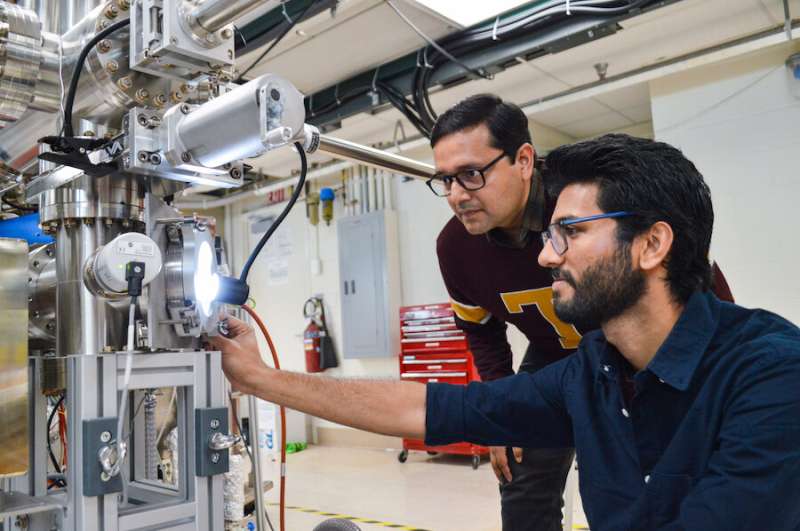
A University of Minnesota Twin Cities-led team has developed a first-of-its-kind, breakthrough method that makes it easier to create high-quality metal oxide thin films out of “stubborn” metals that have historically been difficult to synthesize in an atomically precise manner. This research paves the way for scientists to develop better materials for various next-generation applications including quantum computing, microelectronics, sensors, and energy catalysis.
The researchers’ paper is published in Nature Nanotechnology.
“This is truly remarkable discovery, as it unveils an unparalleled and simple way for navigating material synthesis at the atomic scale by harnessing the power of epitaxial strain,” said Bharat Jalan, senior author on the paper and a professor and Shell Chair in the University of Minnesota Department of Chemical Engineering and Materials Science.
“This breakthrough represents a significant advancement with far-reaching implications in a broad range of fields. Not only does it provide a means to achieve atomically-precise synthesis of quantum materials, but it also holds immense potential for controlling oxidation-reduction pathways in various applications, including catalysis and chemical reactions occurring in batteries or fuel cells.”
“Stubborn” metals oxides, such as those based on ruthenium or iridium, play a crucial role in numerous applications in quantum information sciences and electronics. However, converting them into thin films has been a challenge for researchers due to the inherent difficulties in oxidizing metals using high-vacuum processes.
The fabrication of these materials has perplexed materials scientists for decades. While some researchers have successfully achieved oxidation, the methods used thus far have been costly, unsafe, or have resulted in poor material quality.
The University of Minnesota researchers’ solution? Give it a stretch.
While attempting to synthesize metal oxides using conventional molecular beam epitaxy, a low-energy technique that generates single layers of material in an ultra-high vacuum chamber, the researchers stumbled upon a groundbreaking revelation. They found that incorporating a concept called “epitaxial strain”—effectively stretching the metals at the atomic level—significantly simplifies the oxidation process of these stubborn metals.
“This enables the creation of technologically important metal oxides out of stubborn metals in ultra-high vacuum atmospheres, which has been a longstanding problem,” said Sreejith Nair, first author of the paper and a University of Minnesota chemical engineering Ph.D. student. “The current synthesis approaches have limits, and we need to find new ways to push those limits further so that we can make better quality materials. Our new method of stretching the material at the atomic scale is one way to improve the performance of the current technology.”
Although the University of Minnesota team used iridium and ruthenium as examples in this paper, their method has the potential to generate atomically-precise oxides of any hard-to-oxidize metal. With this groundbreaking discovery, the researchers aim to empower scientists worldwide to synthesize these novel materials.
The researchers worked closely with collaborators at Auburn University, the University of Delaware, Brookhaven National Laboratory, Argonne National Laboratory, and fellow University of Minnesota Department of Chemical Engineering and Materials Science Professor Andre Mkhoyan’s lab to verify their method.
“When we looked at these metal oxide films very closely using very powerful electron microscopes, we captured the arrangements of the atoms and determined their types,” Mkhoyan explained. “Sure enough, they were nicely and periodically arranged as they should be in these crystalline films.”
More information:
Sreejith Nair, Engineering metal oxidation using epitaxial strain, Nature Nanotechnology (2023). DOI: 10.1038/s41565-023-01397-0. www.nature.com/articles/s41565-023-01397-0
Journal information:Nature Nanotechnology
Provided by
University of Minnesota

READ MORE
What Is the Rosetta Stone and Why Is the Artifact Important?
Getty Images Ancient Egypt conjures up images of bearded pharaohs, mighty pyramids and gold-laden tombs. [...]
Black Hole Rap
I’ve been reading all the news about the Large Hadron Collider for months, but apparently [...]
Monkeys May Recognize False Beliefs—Knocking Over Yet Another Pillar of Human Cognition
Are orangutans aware that others have different minds than their own? Barbara Vallance / Alamy [...]
Are Americans Stuck to their Cubicles?
A study by the Centers for Disease Control and Prevention found that most Americans engage [...]
This Wearable ‘Heart Sock’ May Someday Save Lives
This “heart sock” is dotted with sensors that can detect the intricate inner workings of [...]
7 Countries Home to the World’s Healthiest People
Mike Powell/Thinkstock / DCL They live well into their nineties and often times up break [...]
What We Learned About Our Human Origins in 2018
he famous “Catwalk Site,” one of the open air displays at the National Museums of [...]
World’s Largest Wolves by Weight: The Mighty and the At-Risk
Every gigantic wolf starts out small. This gray wolf pup will likely top out at [...]